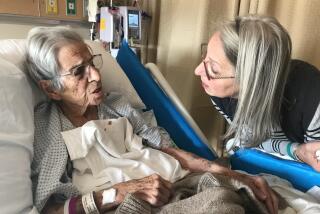Column: When hospice care goes wrong, where can you turn?
When our mother died last month, after a bungled transfer from hospital to residential hospice care that caused her unnecessary pain and distress, my siblings and I briefly considered suing.
It wasn’t about money. As my sister said at the time, it just didn’t seem right to let the hospice agency — which acknowledged and apologized for its failures — keep operating the same way without being held accountable.
But a drawn-out court battle didn’t seem like much of a solution.
Was there another option?
Yes, said Charlene Harrington, a professor at the UC San Francisco nursing school and a former official with the state Department of Public Health. For years, Harrington has been one of California’s chief elder care advocates and a critic of the lack of regulatory oversight and useful information for consumers.
To Grace Lopez with love — and apologies that your end wasn’t better »
Harrington said grieving families are often too busy after a death making funeral arrangements and trying to move on with their lives, or they’re unaware that there’s a formal complaint process if they’re unhappy with the hospice care received by a loved one. And besides, hospice is for people close to death, so it’s not always easy to determine what should and shouldn’t be reported.
“People don’t know to complain, and for the most part, they don’t know there’s a state website for that,” said Harrington.
So even with more than 1,300 hospice agencies in California serving a growing population of patients, the number of complaints filed is small. And, as I would discover, fines are extremely rare.
Harrington referred me to the state Department of Public Health Licensing and Certification Program, which she ran during Gov. Jerry Brown’s first term back in the 1970s. It was confusing, but I finally clicked on “complaint” and got kicked over to the Cal Health Find Database, where I entered the name of the hospice agency, filled out a complaint form and submitted it.
I’ll let you know how that goes, but it could take awhile.
Mike Connors of California Advocates for Nursing Home Reform helped me locate and navigate state records that suggest some alarming shortcomings in oversight of hospice agencies.
“They don’t do a whole hell of a lot,” he said of state regulators.
In 2016-17, the last fiscal year for which data are available, the Department of Public Health received 213 hospice complaints, according to records. Connors agrees with Harrington that the relatively small number is because the general public simply isn’t aware that a hospice complaint process exists.
Those 213 complaints remained open investigations for an average of 358 days, said Connors, which suggests I may be waiting a year to hear the results of the complaint I filed last week. And Connors found evidence in state records of only one penalty imposed against a hospice agency in 2016-17.
At 92, Happi Hicks is ‘too blessed to be stressed.’ All hospice care should be this way »
“Nursing homes always have a very high priority and hospice has always been way down on the list of priorities. That just seems wrong,” said Connors. It may have made sense when hospice care was a small nonprofit enterprise, Connors said, but it has evolved into what is largely a corporate for-profit industry that costs Medicare roughly $18 billion annually in the United States.
When I asked Connors if California was complying with a federal requirement to recertify hospice agencies every three years, his answer was at least as alarming as the rest of what he had to say.
Roughly 80% of hospice agencies, records show, are not reviewed and recertified by the state. Instead, Connors said, they opt to pay private accreditation companies to evaluate their performance. That’s allowable, Connors said, but it’s a system fraught with potential for “huge conflicts of interest.”
I wanted to hear what the state had to say about all of this, so I sent a list of questions on Thursday to the Department of Public Health. I wanted to know why there appear to be so few sanctions, and how we can expect greater accountability without them, and I wanted to know whether, given the aging population and growth of hospice, the state intends to do more to let people know there’s a complaint process. Late on Friday, I got an email from a state spokesman who said he wouldn’t be able to give me any answers until next week. So stay tuned for that.
I should say, as I have before, that I’m a big believer in the benefits of hospice care, and it appears the vast majority of families have positive experiences. I’ll never forget the professionalism and compassion of individual hospice nurses and attendants I met in the final days of my parents’ lives.
But boomers are headed for the finish line in greater numbers than ever without the benefit of adequate oversight of the hospice industry and without enough information to choose the right agency.
For years, Harrington tried to fill the void with a consumer-friendly website -- CalQualityCare.org. The joint operation between UCSF and the California Health Care Foundation compiled data from various sources to give consumers a road map and tip sheet for choosing good care facilities and avoiding those with reported deficiencies. For hospice agencies, the site had a ratings system that was easy to use.
But CalQualityCare ran out of money several years ago and is looking for a new sponsor.
In the meantime, Harrington said, consumers don’t know where to look for information, and no one place has all the useful data. If consumers happen to find it, the website medicare.gov/hospicecompare has reviews of hospice agencies, and it’s possible, though not easy, to find records of complaints like the one I filed on the California Department of Public Health website.
Harrington said that with so many patients going directly from hospital to hospice, as my mother did, hospitals need to do a much better job of helping families educate themselves on hospice options, and they need to allow them adequate time to make informed decisions before discharging dying patients.
I told Harrington that to our family, my mother’s discharge felt rushed by the hospital. She was suffering from kidney disease, heart problems, dementia and delirium, and there was pressure to quickly choose a hospice agency. It did not seem to us that we had any option but moving my mother quickly.
As a result, she was transported to a hospice facility in distress, without being sedated, and with none of her prescribed medication. My sister was in a panic, trying to calm our mother while calling the hospice agency to ask why they hadn’t sent a nurse, as promised. This went on for hours.
Harrington put the blame on both the hospice agency and the hospital.
“They want to get you out the door,” Harrington said of hospitals. “This is one of the problems I’ve been fighting for years.”
Hospice care, as one doctor told me, is like the rest of American health care. It’s often great and sometimes not. We can’t expect dying to always be a smooth or pain-free process, but terminally ill patients in their final days shouldn’t have to suffer unnecessarily.
I’m still going through the mail from my first hospice column, but if you’ve got a story to share, send it my way.
Get more of Steve Lopez’s work and follow him on Twitter @LATstevelopez
More to Read
Start your day right
Sign up for Essential California for news, features and recommendations from the L.A. Times and beyond in your inbox six days a week.
You may occasionally receive promotional content from the Los Angeles Times.







